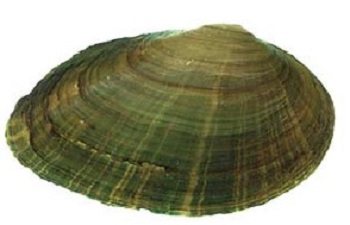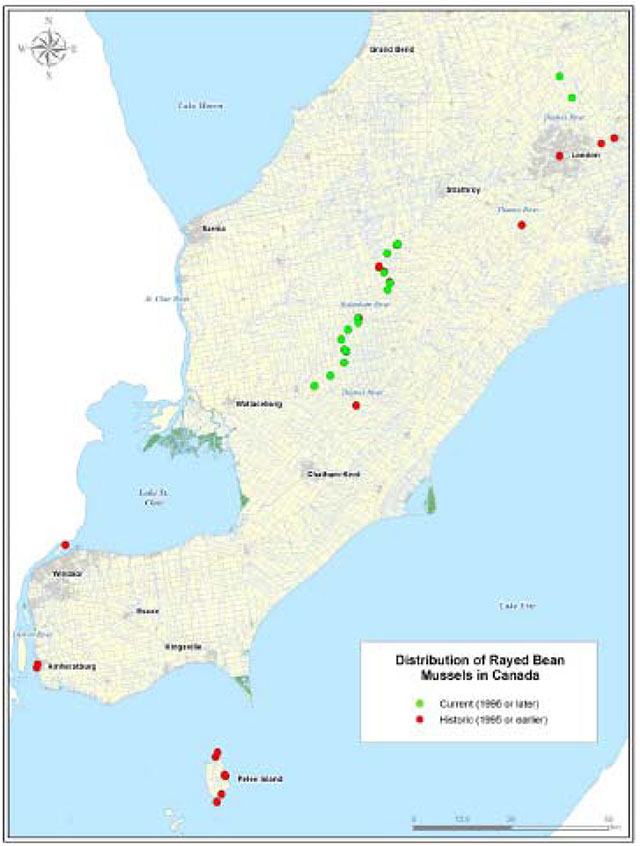Rayed bean evaluation
This document describes the Committee on the Status of Species at Risk in Ontario’s evaluation of the rayed bean. This evaluation determines whether the species will receive protection under the Endangered Species Act.
Committee on the Status of Species at Risk in Ontario (COSSARO) Assessed June 2010 by COSSARO as Endangered

Photo by E. Pip (University of Winnipeg)
http://www.dfo-mpo.gc.ca/species-especes/species-especes/images/rayedbean-villeuseharicot_2.jpg [link inactive]
Part 1: COSSARO candidate Species at Risk evaluation form – June 2010
Rayed Bean (Villosa fabalis)
Current designations:
GRANK – G2 (NatureServe 2010)
NRANK Canada – N1 (NatureServe 2010)
COSEWIC – Designated Endangered in April 1999. Status re-examined and confirmed in May 2000 and April 2010. http://www.cosepac.gc.ca/eng/sct1/searchdetail_e.cfm?id=581&StartRow=1&boxStatus=All&boxTaxonomic=All&location=All&change=All&board=All&
commonName=rayed%20bean&scienceName=&returnFlag=0&Page=1 (accessed May 19 2010) [link inactive]
SARA – Endangered (Schedule 1) http://www.sararegistry.gc.ca/default_e.cfm (accessed May 19 2010) [link inactive]
General Status Canada – At Risk href=http://www.wildspecies.ca/wildspecies2005/search.cfm?lang=e&sec=9 ] (accessed May 19 2010) [link inactive]
ESA 2007 – Endangered /page/species-risk]
SRANK – S1 (NatureServe 2010)
General Status Ontario – At Risk http://www.wildspecies.ca/wildspecies2005/search.cfm?lang=e&sec=9 (accessed May 19 2010) [link inactive]
Distribution and status outside Ontario:
Historically occurred discontinuously in Ontario and 11 central U.S. states, from central Michigan south to Alabama, east to New York, Pennsylvania and Virginia, and west to Illinois. Range included the Ohio and Tennessee river systems, western Lake Erie, Lake St. Clair, and their tributaries.
Eligibility criteria
Native status
Yes. Historical records from Ontario.
Taxonomic distinctness
Yes. Clearly a distinct species, although genetic studies are suggesting that Rayed Bean may not be a member of the genus Villosa (COSEWIC 2010). No known distinctions among populations that warrant separate DUs (COSEWIC 2010).
Priority-setting criteria
Recent arrival in Ontario
No. Not a recent arrival, located in surveys back to 1930's.
Non-regularly occurring species
No. A regularly occurring species in Ontario.
Primary criteria (rarity and declines)
-
Global rank
Endangered. Ranked globally as G2 (NatureServe 2010)
-
Global decline
Endangered. Absent from >50% of its original, natural global range. Generally recognized as having rapidly declined throughout its global range; 78% of streams that were formerly occupied no longer have viable populations (22 streams and a lake currently compared to 106 water bodies historically) (NatureServe 2010). Declines of 50-70% projected short-term and 50-75% long-term, and no longer present in over 50% of the U.S. states where it originally occurred (NatureServe 2010). Range is also fragmented and only a small proportion of former populations still exist.
-
Northeastern North America ranks
Endangered. Extant in 10 jurisdictions, ranked in 10 jurisdictions, ranked as S1, S2, SH or SX in 10 of 10 jurisdictions (100%) where it occurs) (NatureServe 2010).
-
Northeastern North America decline
Endangered. A non-cyclical population decline of >50% has occurred within the species' original, natural northeastern North American range from historic times to the present. "This species has also been eliminated from long reaches of former habitat in hundreds of miles of the Maumee, Ohio, Wabash, and Tennessee Rivers and from numerous stream reaches in their tributaries. In addition, the species is no longer known from the States of Illinois, Kentucky, (Tennessee) Virginia, West Virginia, (and Alabama) representing over half of the states from which it was formerly known" (NatureServe 2010) (States in brackets not considered a northeastern North America jurisdiction).
-
Ontario occurrences
Threatened. Nine Element Occurrences (EOs) in Ontario. Rayed Bean is restricted to only the Sydenham and Thames river systems (COSEWIC 2010).
-
Ontario decline
Threatened. Rayed Bean is absent from >50% of its documented element occurrences in Ontario or a non-cyclical population decline of >50% has occurred within the species' original, natural range in Ontario, from historic times to the present (based upon comparative map in Morris and Burridge (2010) (Appendix). In Ontario originally occurred in the Lake Erie and Lake St. Clair drainage systems, including the Detroit River, Sydenham River, Thames River, and western Lake Erie, but now restricted to the Sydenham and Thames rivers, and considered extirpated from western Lake Erie and the Detroit and South Thames rivers (COSEWIC 2010).
-
Ontario’s conservation responsibility
Threatened. The species' Ontario range comprises >10% and <25% of the global geographic range.
Secondary criteria (threats and vulnerability)
-
Population sustainability
Insufficient information. However, a small number of individuals were found at 2 new sites on the North Thames River (COSEWIC 2010). Although historically rare, populations in the Sydenham River are relatively abundant and larger than historically thought (COSEWIC 2010).
-
Lack of regulatory protection for exploited wild populations
Not in any category. Protected from harm, harassment and take under the Endangered Species Act, 2007. Molluscs are protected under the Fisheries Act, while commercial and recreational harvest is regulated under the Fish and Wildlife Conservation Act.
-
Direct threats
Endangered. Limited locations mean that the species can be readily impacted by negative changes in habitat conditions. The main threats are the deterioration of water quality due to siltation, urbanization, nutrient enrichment from intensive agriculture, contaminants and thermal effects from the loss of riparian zones (COSEWIC 2010, Morris and Burridge 2010). The Sydenham and Thames rivers are both subject to intensive agriculture. Invasive species considered detrimental to Rayed Bean include Zebra (Dreissena polymorpha) and Quagga mussels (D. rostiformis) (rendering habitat unsuitable) and Round Goby (Neogobius melanostomus) (impacts on resource use and host fish species). Native unionids almost completely eradicated from Lake St. Clair, Lake Erie, and Detroit and Niagara rivers within a decade of Zebra Mussel invasion (COSEWIC 2010).
-
Specialized life history or habitat-use characteristics
Threatened. At a high level of risk from environmental change or disturbance because of very specialized life history characteristics. Rayed Bean is dependent upon the maintenance of suitable habitat conditions for host species (Rainbow Darter, Greenside Darter, Mottled Sculpin, Largemouth Bass). Dependent upon presence of fast-flowing rivers with sand or gravel substrates (COSEWIC 2010).
COSSARO criteria met (primary/secondary)
- Endangered – [4/1]
- Threatened – [3/1]
- Special concern – [0/0]
Recommended status:
Endangered
Summary
This is a small freshwater mussel with a limited northeastern North American distribution. In Ontario, it now occurs only in two rivers, and it has been extirpated from a large portion of its former range. The population in the Sydenham River appears relatively abundant and stable, whereas the Thames River population is much smaller. With only 9 elemental occurrences in 2 river systems, this species is extremely vulnerable to environmental perturbations. Primary threats include the deterioration of water quality due to siltation, urbanization, nutrient enrichment from intensive agriculture, contaminants, thermal effects from the loss of riparian zones, and the detrimental effects of invasive species such as Zebra Mussel, Quagga Mussel and Round Goby (Neogobius melanostomus). There is little potential for rescue effect. This species is Endangered in Ontario.
Information sources
COSEWIC. 2010. Update COSEWIC Status Report on Rayed Bean Villosa fabalis. Committee on the Status of Endangered Wildlife in Canada, Ottawa. Two-month Interim Report (Feb. 2010). 41 pp..
Morris, T.J. and M. Burridge. 2010. Draft Recovery Strategy for the Northern Riffleshell (Epioblasma torulosa rangiana), Snuffbox (Epioblasma triquetra), Round Pigtoe (Pleurobema sintoxia), Mudpuppy Mussel (Simpsonaias ambigua) and Rayed Bean (Villosa fabalis) in Ontario. Ontario Recovery Strategy Series. Prepared for the Ontario Ministry of Natural Resources, Peterborough, Ontario. II + 4 PP+ Appendix viii + 76 pp.
NatureServe. 2010. NatureServe Explorer: An online encyclopedia of life [web application]. Version 7.1. NatureServe, Arlington, Virginia. http://www.natureserve.org/explorer. (Accessed: May 19 2010).
Appendix 1: Northeastern North America Rank, status and decline footnote 1
| Region | Rank |
|---|---|
| CT | Not present |
| DE | Not present |
| IL | SX |
| IN | S1 |
| IA | Not present |
| KY | SX |
| LB | Not present |
| MA | Not present |
| MB | Not present |
| MD | Not present |
| ME | Not present |
| MI | S1 |
| MN | Not present |
| NB | Not present |
| NF | Not present |
| NH | Not present |
| NJ | Not present |
| NS | Not present |
| NY | S1 |
| OH | S1 |
| ON | S1 |
| PA | S1S2 |
| PE | Not present |
| QC | Not present |
| RI | Not present |
| VA | SX |
| VT | Not present |
| WI | Not present |
| WV | SH |
Occurs as a native species in 10 of 29 northeastern jurisdictions SRANK or equivalent information available for 10 of 10 jurisdictions = 100% S1, S2, SH, or SX in 10 of 10 = 100%
Part 2: Ontario evaluation using COSEWIC criteria
Regional (Ontario) COSEWIC criteria assessment
Criterion A – declining population
No. Recent population trends in Sydenham River appear stable.
Criterion B – small distribution and decline or fluctuation
Yes (endangered). B1.a and b(iii); B2.a and b(iii). Small extent of occurrence (678 km²) and small index of area of occurrence (180 km²) (COSEWIC 2010). Considered severely fragmented (9 EOs, but at only 2 locations - Thames and Sydenham rivers). Inferred continuing decline in habitat.
Criterion C – small population size and decline
No. Current population in the Sydenham River is estimated at about 1,500,000 indiviuals.
Criterion D – very small or restricted
Yes (Threatened). Limited to only 2 rivers, which are collectively vulnerable to human disturbance or stochastic events in a very short time frame.
Criterion E – quantitative analysis
No. Not conducted
Rescue effect
No. Extant populations in Ontario "are isolated from one another and from populations in the U.S. by large distances (40-700 km) (COSEWIC 2010). With the exception of Largemouth Bass, the other 3 known host fish species are not capable of the large- scale movements required to connect populations (COSEWIC 20910).
Appendix 2. Distribution of the Rayed Bean in Canada (from Morris and Burridge 2010)

Enlarge Appendix 2. Distribution of the Rayed Bean in Canada